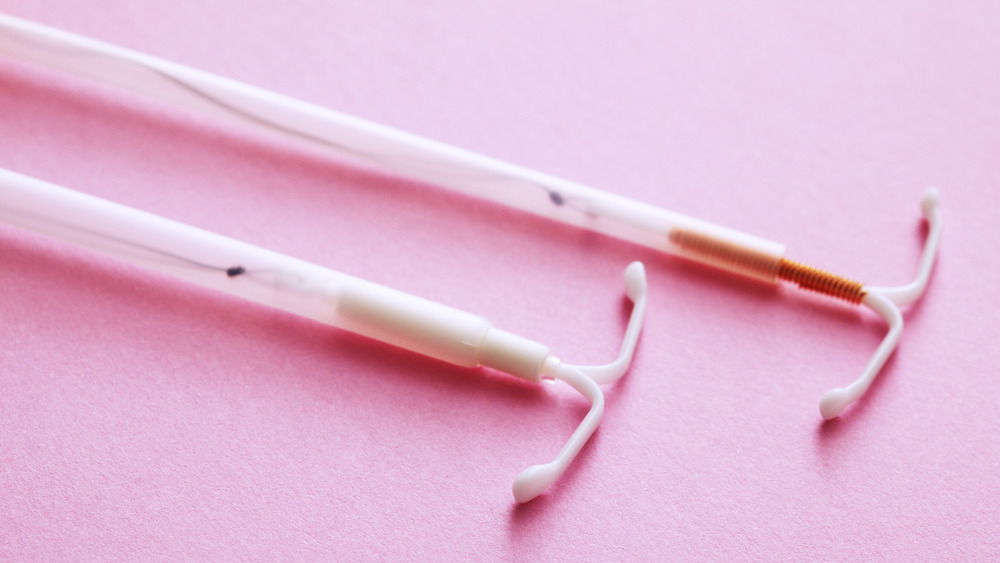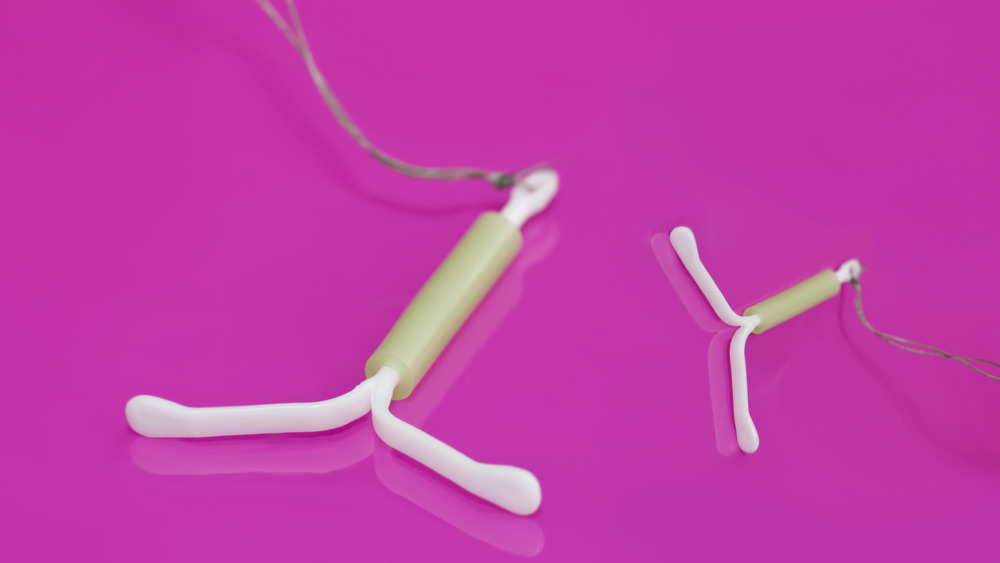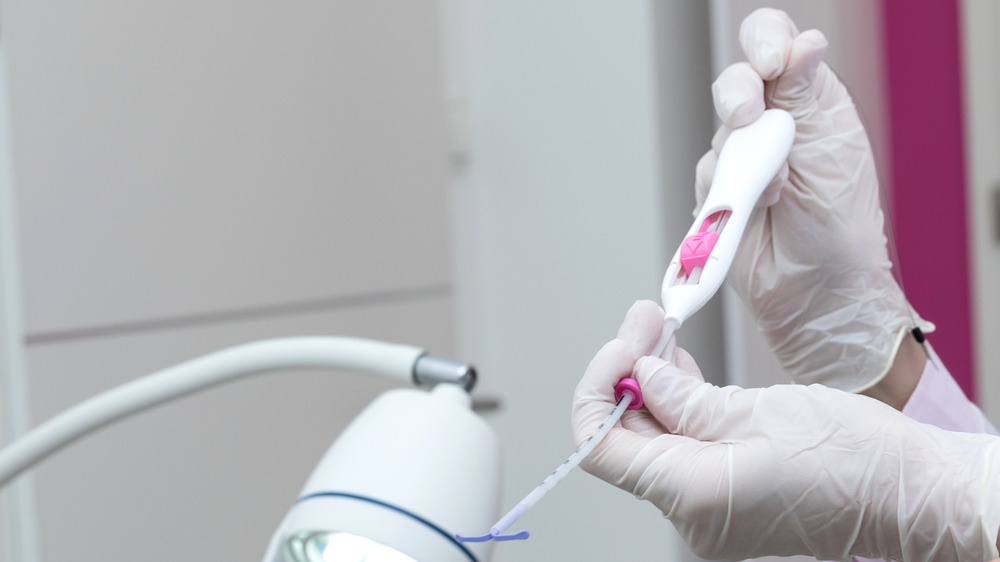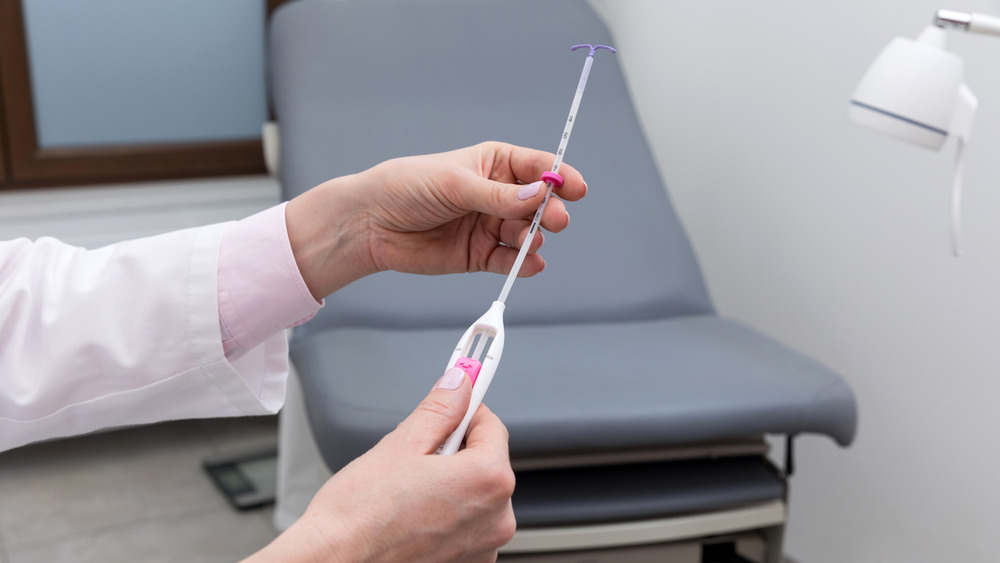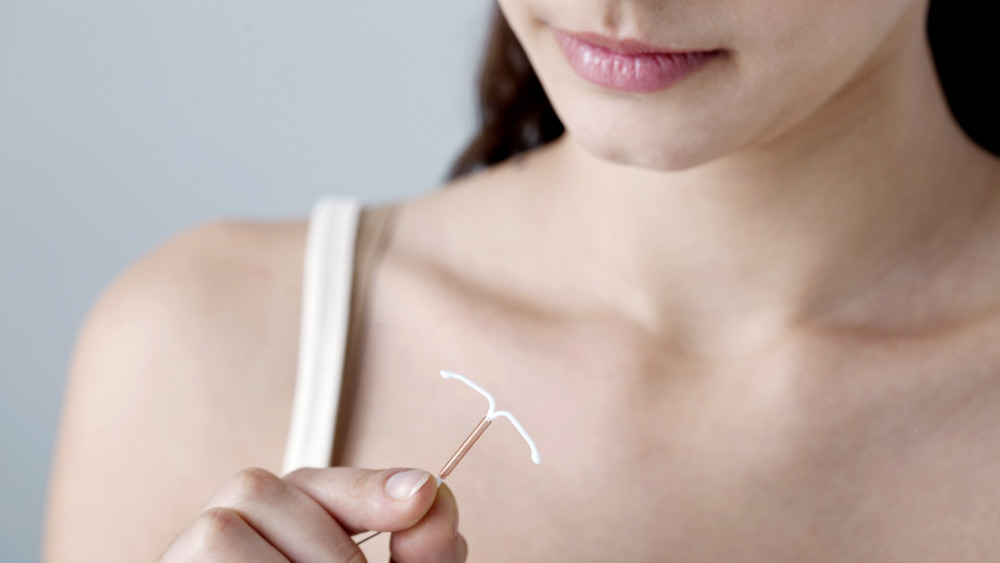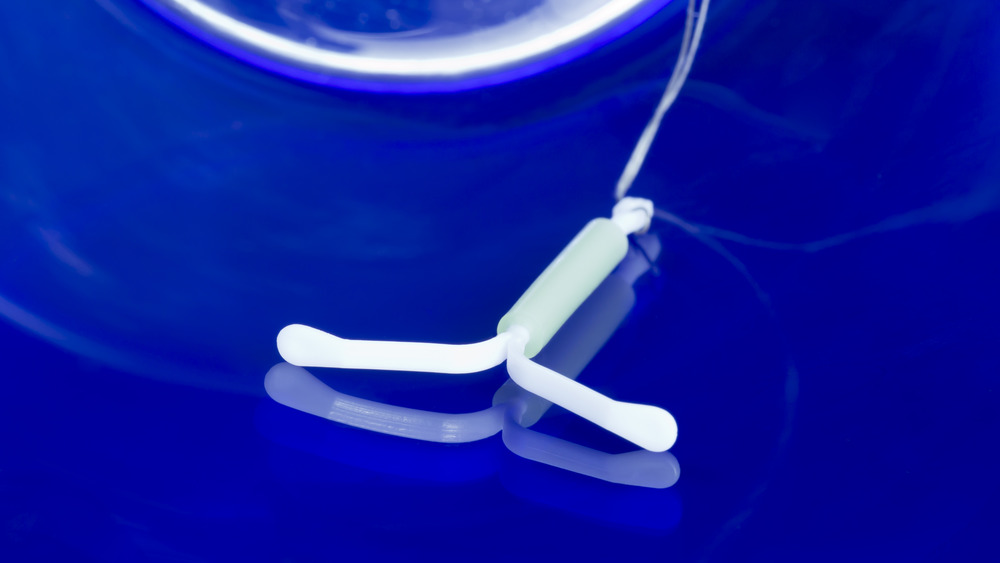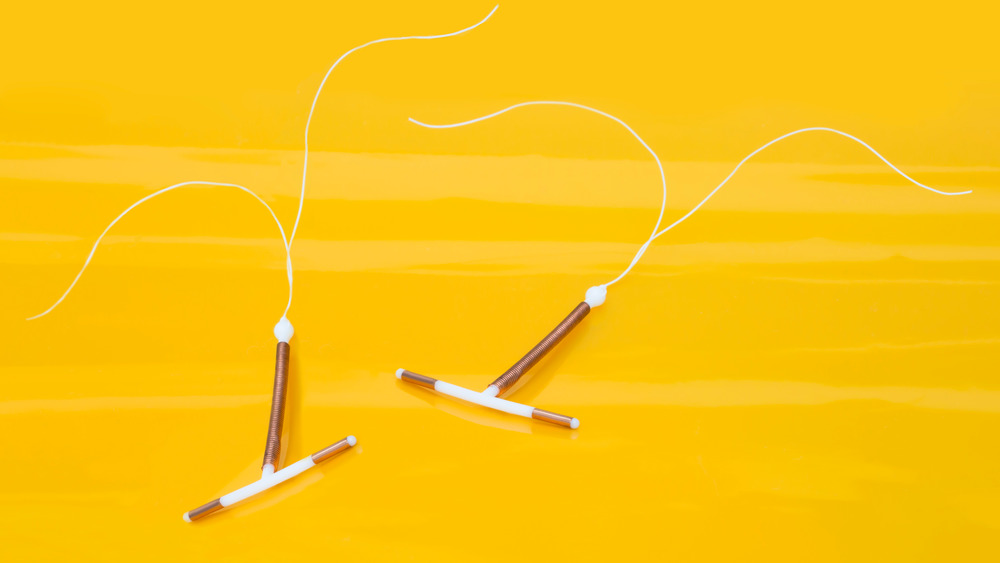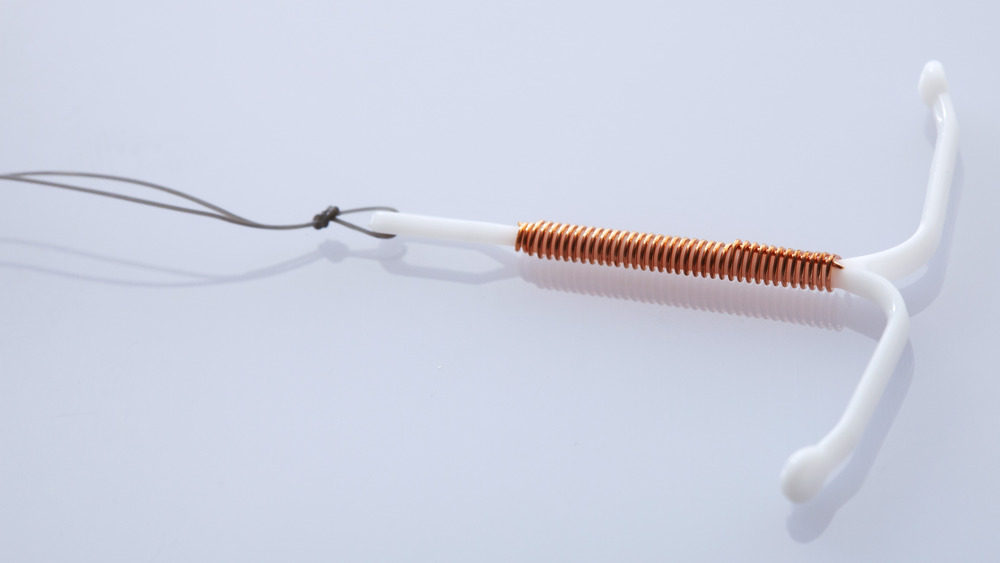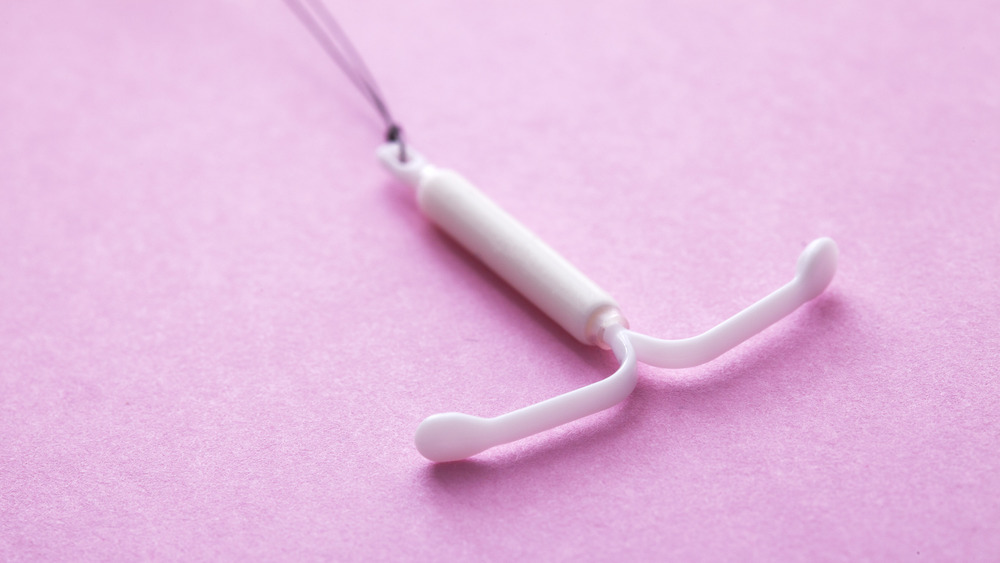Read This Before You Think About Getting An IUD
An IUD, or intrauterine device, is a form of birth control. This type of long-acting reversible contraception does its work from the lining of the uterus. Once it is put in place by a doctor, an IUD can remain in the uterus for years. According to the Centers for Disease Control and Prevention, IUDs along with contraceptive implants are the birth control of choice for 10.3 percent of women between the ages of 15 and 49, which is only slightly less than the percentage of women who use birth control pills.
Invented in 1909, the IUD went through many iterations before it came to take its current form. The original IUD was made from the guts of a silkworm whereas today it is (thankfully) made from plastic or metal. Yes, modern IUDs are either copper (non-hormonal) or polyethylene (hormonal). Both forms of IUDs are considered safe and effective. However, there is a lot to know about how each works and which, if any, would be right for you. So, please, do read this before you think about getting an IUD.
This is how IUDs work
A copper, or non-hormonal, IUD is a tiny, T-shaped piece of flexible plastic wrapped in a thin layer of copper, Kim Langdon, an obstetrician-gynecologist and an advisory board member of telemedicine provider Medzino, told Health Digest. It releases trace amounts of copper, which acts as a spermicide, killing any sperm before they can make their way through the fallopian tubes. The copper IUD may also prevent embryo implantation from occurring in the event any sperm were to survive the journey to the egg,
A hormonal IUD is also a tiny, T-shaped piece of flexible plastic. However, instead of secreting copper, these IUDs secrete a hormone. This hormone works in much the same way as copper as it also prevents embryo implantation. This type of IUD does this by causing the cervical mucus to thicken. The thickened mucus interferes with sperm's ability to swim.
The hormone used in IUDs today is levonorgestrel, which is the same hormone used in Plan B, a form of backup contraception that is intended for use after unprotected intercourse. Neither form of IUD can be said to cause a miscarriage or abortion, Dr. Langdon explained to Health Digest, because a miscarriage/abortion presumes that implantation has occurred.
How effective are IUDs at preventing pregnancy?
The copper IUD will prevent 99.2 percent of pregnancies within its first year of use and, according to OB-GYN Brittany Robles, 98 percent of pregnancies through its useful life. The hormonal IUD is slightly more effective in that it prevents 99.8 percent of pregnancies over its useful life.
The reason why hormonal IUDs may be slightly more effective is that, for some women, the release of levonorgestrel may interfere with ovulation. This is not the primary way that hormonal IUDs prevent pregnancy but, if a woman does not ovulate, she cannot conceive. By contrast, the copper IUD, which contains no hormones, should not have any effect on ovulation.
Neither type of IUD is 100 percent effective, of course, although both are quite close. "The kinds of birth control that work the best to prevent pregnancy are the implant and IUDs — they're also the most convenient to use, and the most foolproof," Planned Parenthood explained.
This is how an IUD is placed
Getting an IUD requires a brief office visit with your OB-GYN. The process, which takes about 10 minutes, according to OB-GYN Madeline Sutton, begins with the woman laying back on the examining table with her legs in stirrups as if she were having a regular gynecological pelvic examination. The doctor uses a speculum to open the cervix (the entrance to the uterus) and to visualize the uterus, which lets the doctor know where and how far to place the IUD.
The IUD, which is enclosed in sterile tubing for the purpose of insertion, is then placed into the uterus. Upon insertion, the IUD is released from the tube. The IUD has strings attached to it, so that it can be readily accessed by a doctor. However, the doctor will most often cut the strings to a length that is no longer than the length of the vagina, Dr. Sutton told Health Digest, and usually considerably shorter.
Your ob-gyn will likely advise you to check your IUD strings between annual appointments. "Doing so is a good way of verifying that your IUD is exactly where it's supposed to be, which is why I encourage my patients to check their strings monthly — at least for the first three months after insertion," OB-GYN Jessica Shepherd explained in an article for Self.
Does it hurt to have an IUD inserted?
Most women do not regard the placement of an IUD as "painful" so much as "uncomfortable," OB-GYN Brittany Robles, advised Health Digest. This discomfort can be due to the speculum, a device made of plastic or metal that is inserted into the vagina and then opened at the cervix. This is the same device used in virtually any gynecological examination, including a Pap test.
Another reason the placement of an IUD can feel uncomfortable is because it may be necessary for the doctor to clamp the cervix to provide "countertraction," as Dr. Robles put it. Additionally, the placement of any foreign object in the uterus can produce uterine cramping, and that cramping may linger on and off for a period of weeks to months after initial placement.
For all of these reasons, Dr. Robles and other female reproductive health practitioners who perform IUD insertions may recommend that patients take a non-steroidal anti-inflammatory medication (like ibuprofen or Advil) about 30 to 60 minutes before the procedure is scheduled.
Your IUD may — or may not — be effective immediately
Whether an IUD is effective immediately upon insertion depends upon which type of IUD you're talking about, Kim Langdon, OB-GYN and advisory board member of telemedicine provider Medzino, told Health Digest. Copper (non-hormonal) IUDs are effective upon insertion because they immediately begin secreting copper, which acts as a spermicide.
Hormonal IUDS can be effective immediately upon insertion if the insertion is timed precisely to occur within the first seven days of a woman's menstrual cycle (counting from the first day of her menstrual period). During those first seven days, the egg has not yet been released by the ovary and by the time it is, the hormones will have had an opportunity to have done their work (thickening the cervical mucus and creating an environment in the uterus that is inhospitable to implantation). If the insertion takes place at any other time or if there is any doubt at all about when your menstrual cycle began, you should use backup contraception for one week as it can take that long before the IUD is considered effective.
Yes, your IUD can fall out
It's true, IUDs can fall out spontaneously. However, this is by no means an everyday occurrence, OB-GYN Brittany Robles confirmed to Health Digest. The expulsion rate is anywhere from 2 to 10 percent in the first year. Hormonal IUDs also tend to be expelled more often than copper IUDs, according to Jodie Horton, OB-GYN and the chief wellness advisor for Love Wellness. The first year after IUD insertion is when expulsion is most likely to occur, but Dr. Horton said it's "not well understood why this happens."
However, research shows that the risk is higher among women who have an IUD inserted immediately after delivery of a baby. The risk is also higher among women under the age of 20 as well as those who have heavy, painful periods or uterine fibroids. Since the advent of the menstrual cup, there have also been reports of women accidentally pulling out their IUDS when removing their menstrual cups, OB-GYN Carol A. Stamm, told Health Digest.
You shouldn't be able to feel your IUD
"You should never be able to feel the IUD, itself, as it is meant to be located in your uterine lining," according to Jodie Horton, OB-GYN and the chief wellness advisor for Love Wellness. "Even during sexual activities, your partner should not be able to feel the IUD, itself." In fact, if you can feel the actual IUD, that merits an immediate call to your doctor because it likely means the IUD has dislodged and is no longer effective at preventing pregnancy.
While the IUD should not be palpable, the strings attached to the end of the IUD (for the purpose of removal) are a different story. It is possible that you or your partner may be able to feel the strings. If you have an IUD and either you or your partner is aware of the strings, you can have your doctor cut them shorter, Kim Langdon, OB-GYN and advisory board member of telemedicine provider Medzino, told Health Digest.
Some IUDs can prevent pregnancy for up to a decade
"One of the best things about an IUD is that it can remain in place and effectively prevent pregnancy for years," OB-GYN Madeline Sutton explained to Health Digest. This gives a whole new meaning to the notion of "set it and forget it." How long a particular IUD can remain in place depends on the type of IUD as well as the brand.
The copper IUD is sold only under the brand name Paragard, and it can be kept in place for up to 10 years. However, there are four different brands of hormonal IUDs. The one sold under the brand name Skyla can remain in place for up to three years whereas the Kyleena IUD can remain in place for five years. Both the Mirena IUD and Liletta IUD can remain in place for up to six years. Of course, you don't have to keep your IUD in place for that many years. Dr. Sutton explained, saying, "You can have it removed whenever you want."
What is involved in removing an IUD?
Having your IUD removed is, in most cases, "pretty quick and simple," according to Planned Parenthood. Unlike with an IUD placement, there is rarely a need for a speculum. The healthcare provider should be able to gently pull on the strings, and the IUD's arms will fold up, allowing it to slip through the cervix. Only on rare occasion does the removal process become more complicated, for example, if the strings can't be located. This may require your doctor to use additional instruments, like a speculum.
Once your IUD is removed, you can have a replacement inserted right away, OB-GYN Natasha Spencer told Bustle. If you opt to have your IUD removed and not replaced, you should assume you're capable of conceiving immediately, Kim Langdon, OB-GYN and advisory board member of telemedicine provider Medzino, told Health Digest.
However, for patients who wish to conceive, Dr. Langdon told Health Digest that she recommends waiting at least one to three menstrual cycles before trying. This allows the uterine lining to heal and regenerate. In addition, it might take several months before ovulation resumes following the removal of a hormonal IUD.
How your IUD affects your period depends on what kind of IUD you have
As the copper IUD is hormone-free, it does not prevent you from ovulating, nor does it in any other way interfere with the menstrual cycle, according to Paragard's website. However, one of the copper IUDs' most common side effects is heavier and longer periods, plus spotting between periods. In most cases, however, these effects abate within the first several months following placement.
Hormonal IUDs, by contrast, are known to affect the menstrual cycle. "Many women report either lighter periods or no periods at all," OB-GYN Madeline Sutton told Health Digest, which is one reason many women choose hormonal IUDs. In fact, the Mirena IUD is specifically FDA-approved for treating heavy menstrual bleeding. In other words, a person can have a Mirena IUD placed solely for the purpose of treating heavy menstrual bleeding as opposed to as a form of contraception.
How soon after childbirth can you get an IUD?
Believe it or not, you can get an IUD pretty much immediately after giving birth. Or, as OB-GYN Brittany Robles explained, as soon as you finish delivering the placenta. This is known as "immediate postpartum birth control," and some doctors counsel all their pregnant patients to consider the option, according to Harvard Women's Health Watch. The reason immediate postpartum birth control may be advisable is that ovulation can occur within a matter of weeks after birth, which means pregnancy can also occur. As such, this greatly lowers the risk of an accidental pregnancy.
From a public health standpoint, immediate postpartum birth control "streamlines women's access to contraception," better empowering her to consciously engage in family planning. One downside, however, is that an IUD placed immediately after birth is "slightly more likely to be expelled" compared with an IUD placed at least six weeks after delivery, according to the publication.
There are some risks to consider before getting an IUD
Minor risks associated with IUDs include cramping and irregular periods during the first few months, OB-GYN Madeline Sutton advised Health Digest. Serious complications are rare but include spontaneous expulsion. If you find that you are no longer able to feel the strings of your IUD, you should see your doctor before engaging in unprotected sex. Speaking of unprotected sex, another risk worth mentioning is that an IUD does not protect against sexually transmitted diseases.
Another serious but common risk is infection or pelvic inflammatory disease, although these risks diminish after a few weeks following placement. It is also possible, though rare, to get pregnant despite the presence of an IUD. If you have an IUD and become pregnant, you should see your healthcare provider as quickly as possible because this scenario presents an increased risk of ectopic pregnancy. Very rarely, an IUD can also push through the wall of the uterus and into the stomach. This phenomenon known as the "wandering IUD" requires surgical removal.
Are you a good candidate for an IUD?
IUDs are a great birth control option for any woman who knows that she does not wish to become pregnant for at least one year or more, according to OB-GYN Richard Beyerlein. This includes women who have already had children, women who have not yet had children but want children in the future, or women who do not want children in the future. In addition, you can opt to use the Mirena hormonal IUD to treat extremely heavy menstrual bleeding regardless of its contraceptive purposes.
Most women can use IUDs safely. That includes women who have recently given birth and those who are still breastfeeding. However, there are circumstances that can make complications more likely. That is why it is important to discuss with your healthcare provider whether an IUD is right for you before making the decision to get one, OB-GYN Tamika K. Cross told Health Digest.
Not everyone should get an IUD
One of the great things about an IUD is that there are not many contraindications to getting one, OB-GYN Brittany Robles told Heath Digest. However, you shouldn't get an IUD if you are actively pregnant or experiencing unexplained vaginal bleeding. You should also avoid getting an IUD if you have a pelvic infection, cervical cancer, or uterine cancer. In addition, women who have been exposed to a sexually transmitted infection or who know they have an active sexually transmitted infection should wait for medical clearance before getting an IUD.
Women who have multiple uterine fibroids may not be good candidates for IUDs, and the same is true for any woman born with an atypically-shaped uterus, according to OB-GYN Peace Nwegbo-Banks. You shouldn't get the non-hormonal copper IUD if you have a copper allergy, a clotting disorder, or Wilson's Disease. With regard to the hormonal IUDs, women with breast cancer are not good candidates. You'll want to consult your OB-GYN to discover what form, if any, of birth control is right for you.
